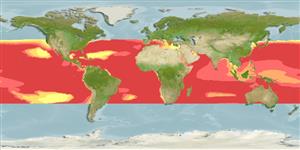Common names from other countries
Environment: milieu / climate zone / depth range / distribution range
Ecologia
marinhas; oceanódromo (Ref. 51243); intervalo de profundidade 0 - 1 m (Ref. 122940). Subtropical; 43°N - 34°S
Subtropical waters of all oceans. Eastern Atlantic: occasional to Spain and English Channel, western Mediterranean (a separate population migrates to the southeastern part in winter), Portugal to Mauritania and from south of Namibia; also off the Cape, South Africa (Ref. 2797). Possibly in Ascension I. (Ref. 98447). Western Atlantic: Massachusetts, USA and Bermuda to southern Brazil (Ref. 7251). Northwest Atlantic: Canada (Ref. 5951).
Tamanho / Peso / Idade
Maturity: Lm ? range ? - ? cm
Max length : 30.0 cm TL macho/indeterminado; (Ref. 7251); common length : 20.0 cm TL macho/indeterminado; (Ref. 3397)
Espinhos dorsais (total): 0; Raios dorsais moles (total): 10-12; Espinhos anais 0; Raios anais moles: 10 - 13; Vértebras: 45 - 47. This species is distinguished by the following characters: elongated body is nearly rectangular in cross-section, almost flat ventrally, its depth 6.2 to 7.9 times in standard length (SL); 45-47 vertebrae; 25-30 predorsal scales; scales in transverse row 6 to 7.5, usually 6.5; the head 4.2-5.2 times in SL: eye 3.1-3.3 times in head; subequal jaws; jaw teeth conspicuous, conical; no palatine teeth; gill rakers on first arch 25-31; dorsal fin low, with 10-12 rays; anal fin with 10-13 rays, originating slightly before, or 1-2 rays behind dorsal-fin origin; pectoral fins 1.3-1.4 times in SL and with 16-18 rays, first 2 rays unbranched; pelvic fins 2.8-3.4 times in SL, inserted slightly nearer to posterior margin of opercle than origin of caudal fin base: juveniles without barbel (Ref. 109257). Colour of body dark, iridescent blue above, silvery white below; dorsal and caudal fins greyish, other fins hyaline (Ref. 2797); pectoral fins black without unpigmented cross-band and with a narrow light outer margin; pelvic fins usually without black spot (Ref. 109257); juveniles elongate, paired fins black (Ref. 2797).
Inhabits oceanic surface waters. Capable of leaping out of the water and gliding for considerable distances above the surface (Ref. 3720). Feeds on zooplankton (Ref. 109257). Eggs with bunch of filaments opposed by a single filament on opposite pole (Ref. 6523). Reported to have no importance to fisheries (Ref. 109257). Depth assumed from ecology data.
Life cycle and mating behavior
Maturidade | Reprodução | Desova | Ovos | Fecundidade | Larvas
Carpenter, K.E. and N. De Angelis (eds.), 2016. The living marine resources of the Eastern Central Atlantic. Vol. 3: Bony fishes part 1 (Elopiformes to Scorpaeniformes). FAO Species Identification Guide for Fishery Purposes, Rome, FAO. pp. 1511-2350. (Ref. 109257)
Categoria na Lista Vermelha da IUCN (Ref. 130435)
CITES (Ref. 128078)
Not Evaluated
Ameaça para o homem
Harmless
Utilização humana
Pescarias: espécies comerciais
Mais informação
ReferênciasAquaculturaPerfil para aquaculturaEstirpesGenéticaElectrophoresesHereditariedadeDoençasProcessamentoMass conversion
Ferramentas
Relatórios especiais
Descarregue XML
Fontes da internet
Estimates based on models
Preferred temperature (Ref.
115969): 15.2 - 27.8, mean 24.5 (based on 1598 cells).
Phylogenetic diversity index (Ref.
82804): PD
50 = 0.5002 [Uniqueness, from 0.5 = low to 2.0 = high].
Bayesian length-weight: a=0.00646 (0.00292 - 0.01429), b=3.04 (2.84 - 3.24), in cm Total Length, based on LWR estimates for this (Sub)family-body shape (Ref.
93245).
Nível Trófico (Ref.
69278): 3.0 ±0.1 se; based on size and trophs of closest relatives
Resiliência (Ref.
120179): Elevada, tempo mínimo de duplicação da população menor que 15 meses (Preliminary K or Fecundity.).
Fishing Vulnerability (Ref.
59153): Low vulnerability (20 of 100).
